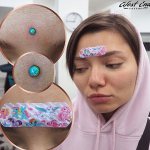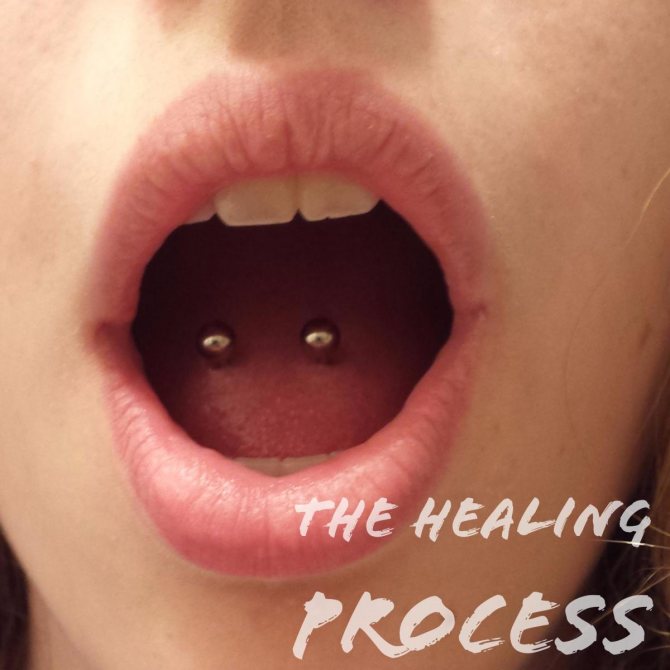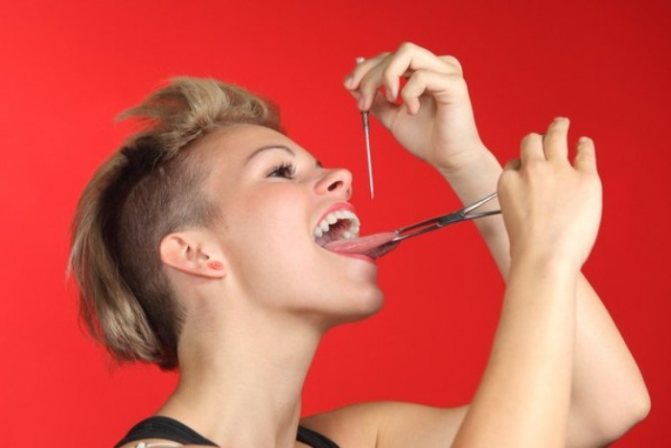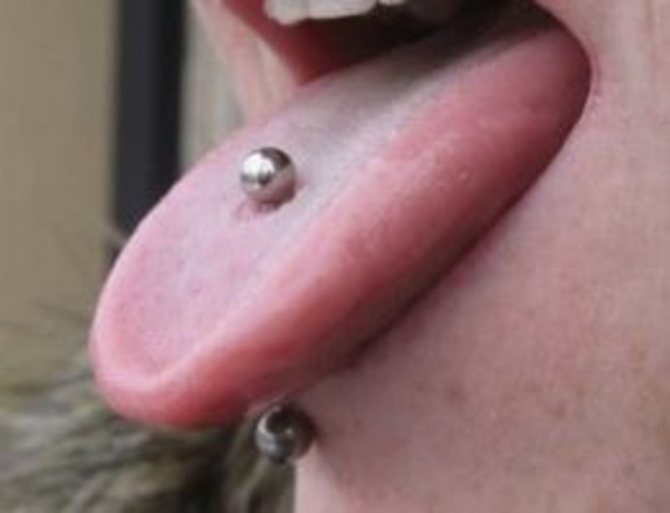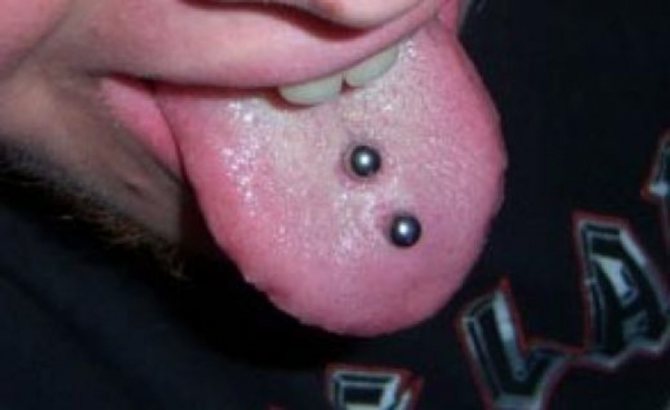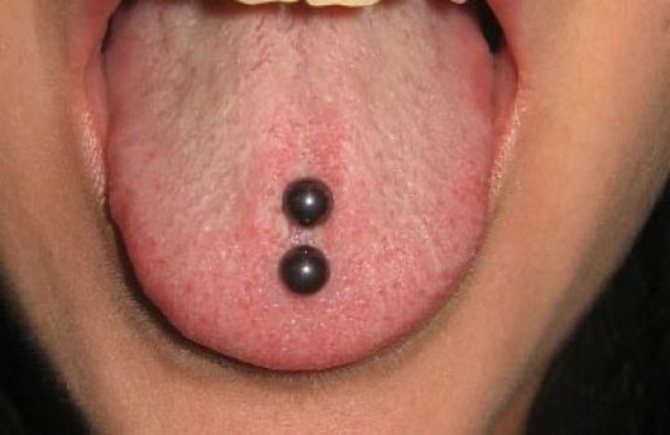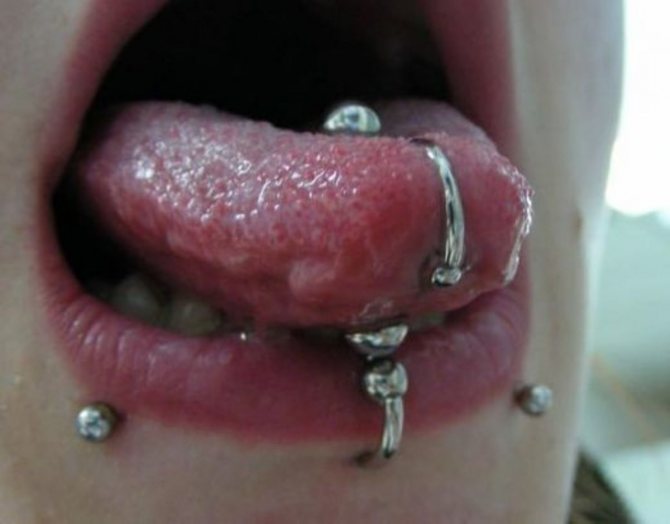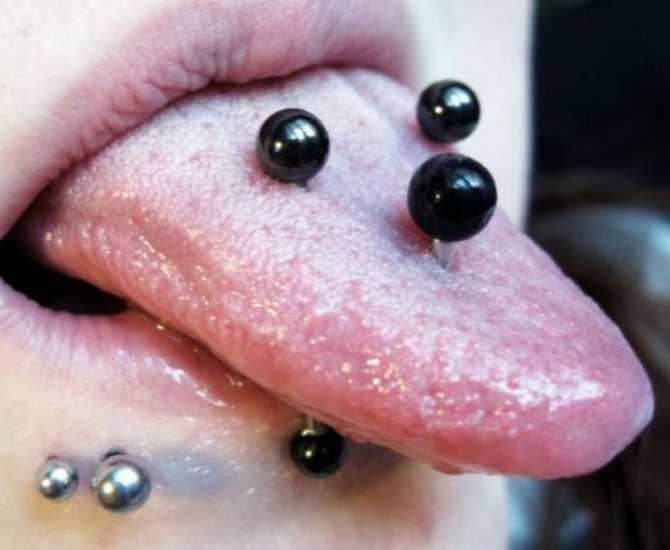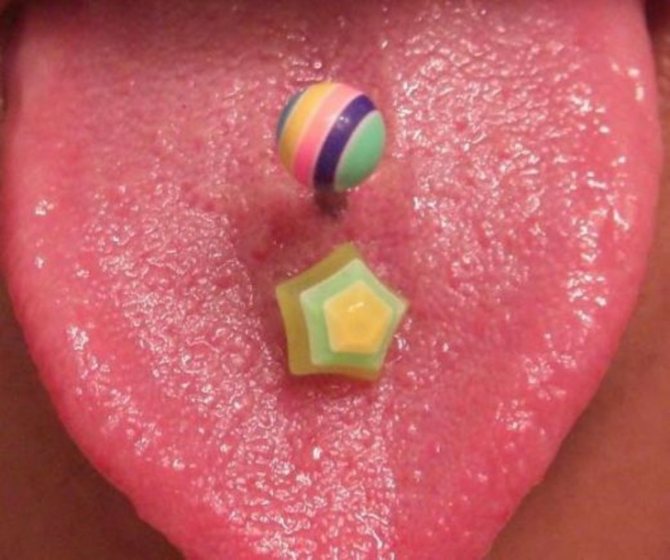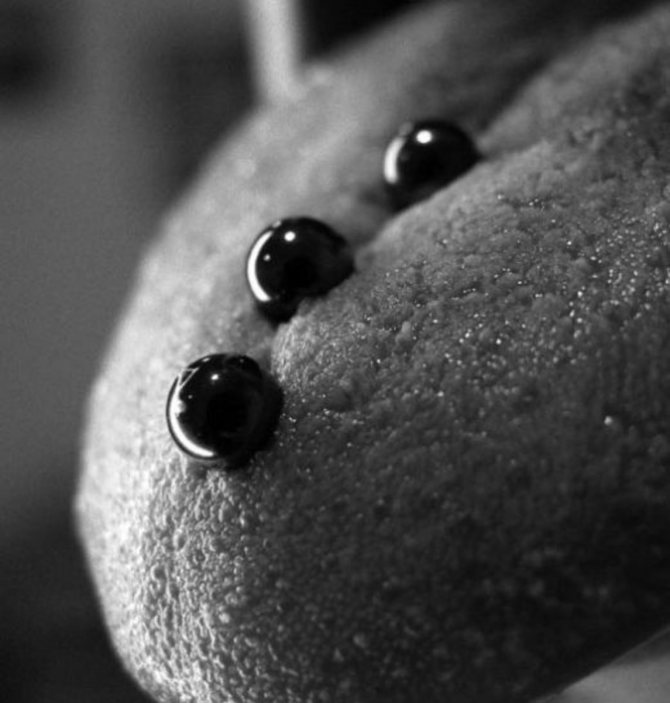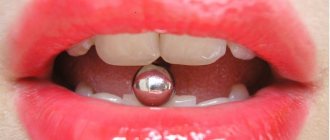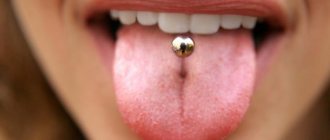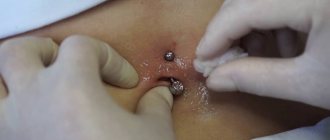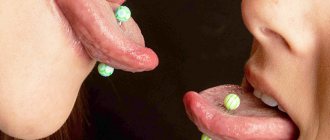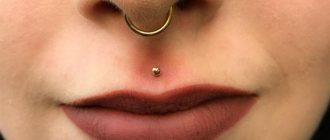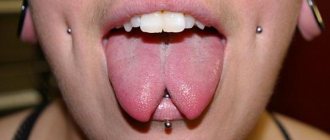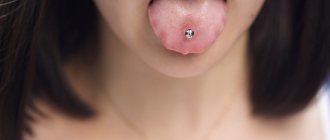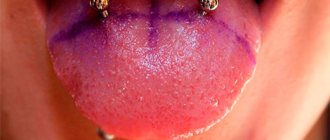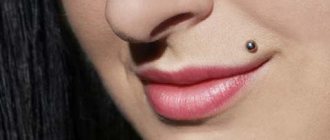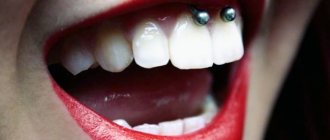Piercing - a popular way to emphasize individuality, to complement the created style, to stand out against the general background. For quick recovery of the skin after piercing and to prevent inflammatory processes and complications it is necessary to pay special attention to the care of the piercing, which depends not only on the quality of service, but also on health in general.
Types of tongue piercings
There are four types of tongue piercing:
► Vertical - From the frenulum to the palate. Classic and the most common piercing.
► Horizontal - The piercing is located at the tip of the tongue, from ear to ear (wide)
► Surface - The piercing is done across the tongue
► Tongue frenulum piercing- Tongue Piercing
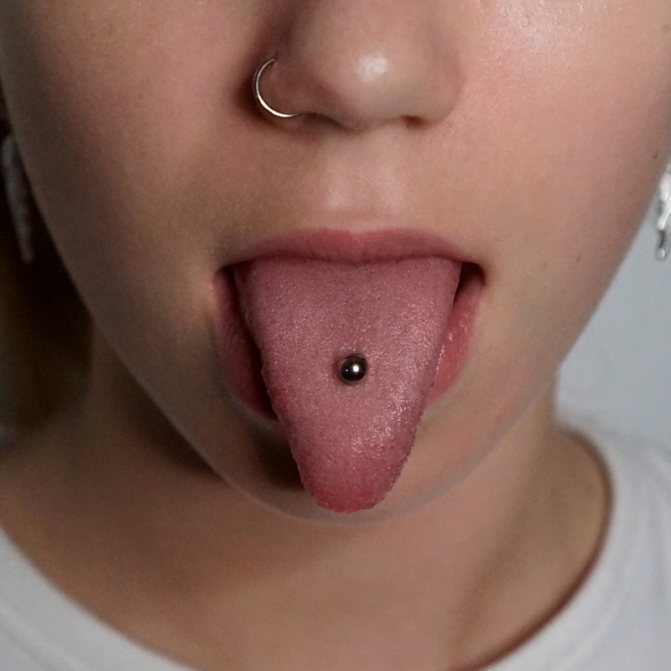
Problems and inflammation
The main problems of tongue piercing healing are improper care, lack of oral hygiene, or the consequences of the healing process aggravated by colds.
Consumption of alcohol and other vasodilators leads not only to an increase in blood pressure, but also to a decrease in basic immune functions. Their suppression will have an extremely negative effect on healing and all the resulting processes. It is worth knowing that lactose (dairy products) with lowered immunity and general inflammation during piercing healing can cause candidiasis.
Be careful with general hypothermia and being in airy rooms. Any colds, viral, moderate or acute infections are extremely detrimental to recovery.
Protect yourself from mechanical damage for at least the first 3 weeks. The cracks formed from them can be an easy and quick way for unwanted microorganisms to enter the wound cavity to heal.
Choosing jewelry for piercings
Jewelry for tongue piercing Must be made of quality material - titanium. Medical steel, gold, silver and other metals in their composition have extraneous alloys that, when in the human body, begin to oxidize, but in the oral cavity, this process is much faster, so the consequences after the tongue piercing with such jewelry will be very unpleasant. For the primary healing is used rod 1.6x22 (sometimes longer, based on individual measurements of the tongue), to a shorter rod can be replaced after 2-3 weeks after the piercing. For those who really wants to pierce the tongue, but has not yet decided, there is a tongue piercing tool - such jewelry is attached to suction cups or magnets.
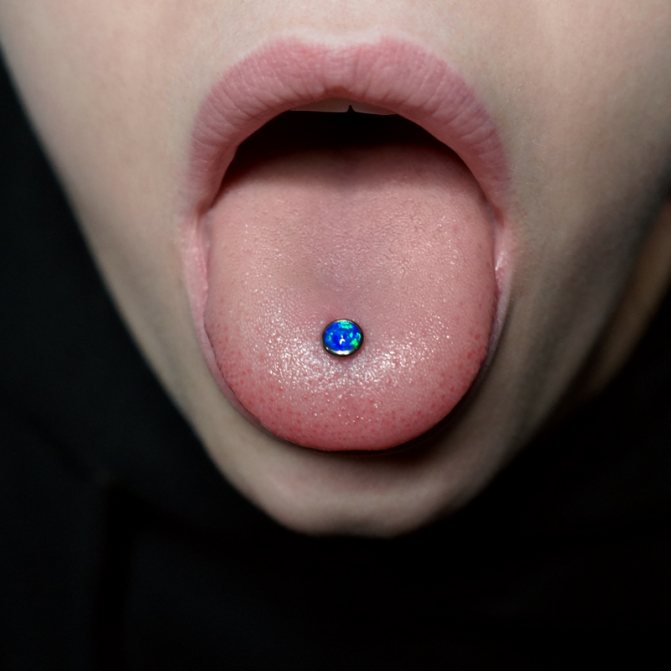

Frequently Asked Questions
Can I get my nose pierced?
On the first day after the session, you should not allow tap water to get on the piercing. On the remaining days, standard hygienic procedures (washing, head washing) can be carried out as usual.
Can I treat my piercing with hydrogen peroxide?
Hydrogen peroxide has no antiseptic and healing properties. It dries and even burns the skin. Therefore, its use is not recommended.
Can I drink before piercing?
You cannot drink alcoholic beverages the day before the session, on the day of the procedure and 2-3 days after it.
Piercing procedure
First of all, the master helps to pick up the jewelry. For the initial healing of the classic piercing of the tongue, a 1.6x22 bar is placed, this is a standard size that, in case of swelling after the piercing, will prevent the jewelry from becoming embedded in the tongue. The bar is fitted with a twist, depending on the client's preferences. Next, the master allows the client to rinse his mouth with octeniseptic and makes a mark, looking at the anatomy of the tongue. After that, the sterilized tools are taken out, the tongue is held with a special round clamp and the piercing needle is pierced, the jewelry is smoothly inserted with the help of a turner and the twist is screwed on. The tongue after piercing will be painful and swollen, but this is not worth fearing, the painful sensations quickly go away if you follow all the recommendations that the master will give you.
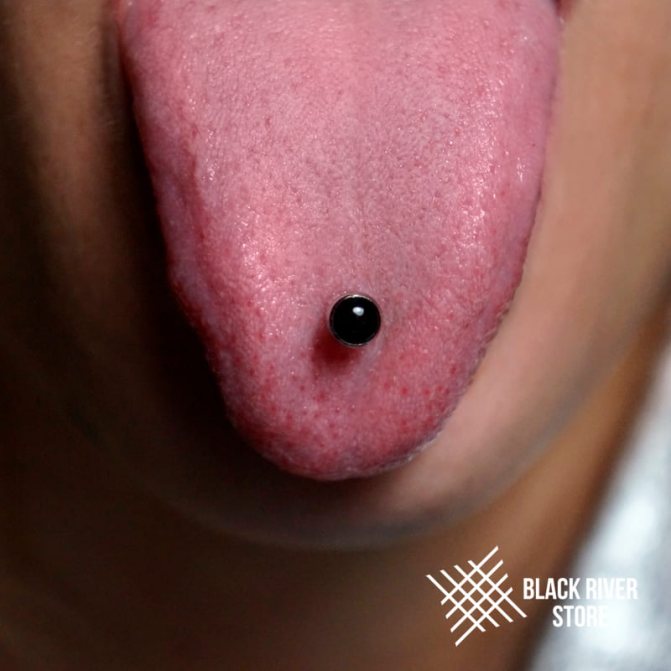

Healing
From two weeks to a month. Fast healing is due to the microflora of the oral cavity and good blood circulation.
Care
Keep in mind that the oral cavity, especially the lingual muscles have strong blood circulation. Because of this, after a piercing procedure, the entire perimeter of the tongue tends to react with moderate to severe swelling. This is a temporary reaction. The swelling goes down on the 4th to 6th day after the procedure.
In addition to general care, an initial liquid diet is extremely important. Nominally eating dairy products, baby food, liquid porridge, pureed soups (already from the 3rd-4th day). From any serious gustatory and thermal stimuli such as spicy, bitter, very salty, sour, hot or very cold food should be abstained, to avoid irritation of the wound surface and slow down the recovery process. You can return to your normal diet from the 6th-7th day after the procedure, doing it gradually.
For general care, an antiseptic of MIRAMISTIN is optimal. Rinsing should be done after each meal and after brushing your teeth. Rinsing with purified water after eating and brushing is not unreasonable, so as not to leave food and toothpaste residue near the wound surface.
The rinse should not last more than 3 weeks. Keep in mind that even a mild oral antiseptic like Miramistin can have a slight "rinsing" effect on your own microflora, depriving it of some of its regenerative and immune abilities. The environment is not sterile and must fight back against foreign microflora.
Tongue piercing care
In order for the piercing to heal well, you need to know how to take care of your tongue piercing. Tongue piercing care involves constant oral cavity treatment - suitable Lacalut rinse, Asept or PresidenteT, rinse your mouth should be 4-5 times a day and after each meal and drink. Swelling after tongue piercing lasts at least 4-5 days, so for this time you have to Refrain from active conversation, hard, spicy and salty food. If you notice that there is plaque after the tongue piercing, do not try to remove it, so you traumatize the piercing. In 2-3 weeks it will be possible to change the barbell to a shorter one (downside).
How do I know if my piercing is infected?
Locating your tongue in a moist environment and in constant contact with external agents, such as food, makes this area a breeding ground for bacteria and germs that can cause infections. If you feel that you are not careful enough to clean the area and begin to feel that your tongue hurts, it is important to consider the following points:
- The appearance of pus in the piercing area: This is a clear symptom of an infection. If you notice whitish, greenish or yellowish fluid pus coming from any area of your tongue, there is no doubt that it is an infection.
- Inflammation and prolonged pain: It takes 6 to 8 weeks for the tongue to heal. Any discomfort that goes beyond this time indicates a possible infection problem.
- Irritation in the tongue: If you feel that the area is irritated and it causes difficulty in swallowing and a sharp pain that becomes unbearable, there is no doubt that your tongue piercing is infected.
- Bleeding: If there is a hemorrhage that causes your tongue to bleed constantly, it means that there is an infection.
- Discoloration of the tongue: the last symptom of a tongue infection is because if the normal tone of your tongue changes to yellowish, green or even black or blue, it means that your tongue is infected.
However, the most effective solution to the appearance of these symptoms is to see a doctor immediately. If your piercing hurts a lot, pus a strange fluid or is annoying, don't hesitate to see a professional. Remember that if you want to get a piercing, you should always put yourself in the hands of a specialized and qualified professional in accordance with current regulations.
If you find a mistake, please highlight the text fragment and press Ctrl+Enter.
How old is the procedure?
Russian law forbids surgical interventions and any medical procedures on a child under the age of 14 without the consent of his parents (or other legal representatives). The consent must be in writing.
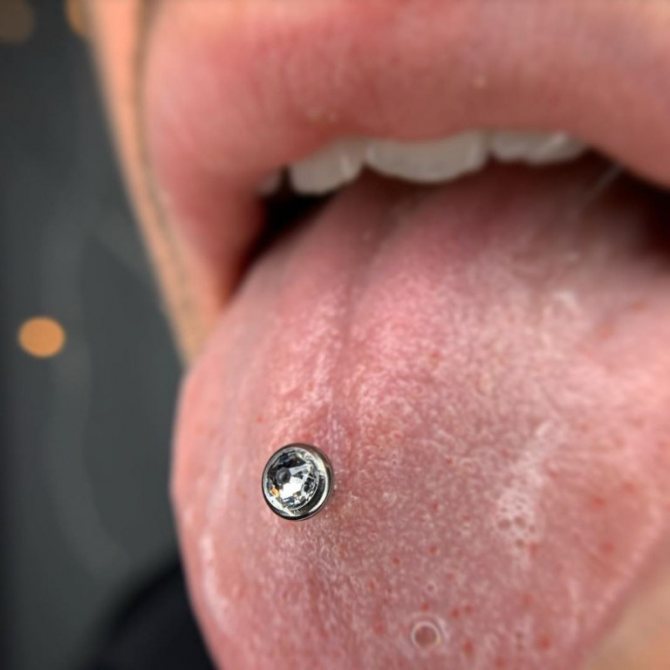

It is possible to get a tongue piercing of your own free will from the age of 18.
In addition to the legal aspect, there is also a medical aspect - a growing body is difficult to tolerate the introduction of foreign objects (piercing earrings, anchors, etc.). As you grow, the location and configuration of the hole may change. Therefore, you should not get a piercing when you are a teenager. The master has every right to ask to see your passport to make sure you are the right age.
Where can I pierce my tongue?
Put an earring only in the salon of a qualified master.


It is very important that the piercer has all the necessary documents confirming the right to perform such procedures.
Attempts to pierce the tongue at home can lead to irreversible consequences, up to sepsis and tissue necrosis. Therefore, in no case can you do piercing at home, friends. Lack of sterility, and often the necessary skills in the "master" is a direct path to complications after the procedure.
Take note! A licensed piercer will never go to pierce the tongue of a minor child without parental consent. If the master is not interested in the age, and immediately offers to proceed with the procedure - this is a sign that he should not be trusted with his health.
What jewelry is suitable?
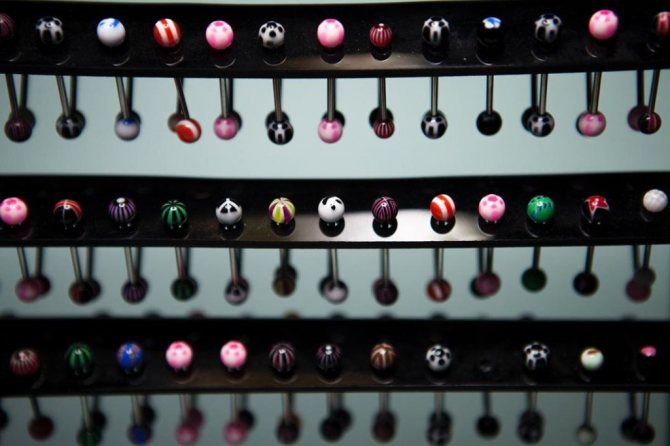

For the first piercing, it is better to use small rods of neat shape, without massive decorations. The rod should not be too thin - it is traumatic for the wound. After the wound has healed, the decoration can be changed. The most common types of piercing decorations are:
- classic rods - a straight rod with decoration at the tips;
- Curved rods (banana and micro banana);
- labret and microlabret - rods of different sizes with a disc on one side and a round fixing element on the other;
- Earring rings of different sizes - used most often for piercing the tip of the tongue, as well as the uvula.
One of the key selection criteria is the hypoallergenic nature of the material. Not suitable for piercing earrings made of silver, gold, nickel-plated steel and brass. It is strictly contraindicated to put wooden and plastic jewelry after the piercing. The ideal option is a titanium rod.
What you should avoid while your tongue is healing
What you should avoid:
- Hard, sour, sticky, spicy foods.
- Talking too much.
- Kissing and any other use of the mouth with girlfriends/friends
- Putting foreign objects in your mouth.
- Smoking (it is better to abstain at first, and once the piercing has healed, to quit smoking altogether)
- Experimenting with jewelry in the tongue (you will have plenty of time for this after the healing)
The swelling should go down in a couple of weeks, but the healing time may take longer.
After a piercing, the tongue usually takes three to four weeks to heal completely. This is one of the fastest-healing piercings, as the enzymes in saliva help fight infection and kill bacteria.
This is interesting: An illustrated guide for belly button piercings
You will need to use a good non-alcoholic mouthwash to help cleanse your mouth, but be careful not to overdo the cleanse, which can cause your tongue to turn green or brown. If this happens, simply reduce the amount of mouthwash you use and how often you use it.
- Day 1-5: after the first day, you will experience bloating. It will be worse for the first five days, when your speech will get in the way, and you may have to change your diet of mashed potatoes, noodles, and other soft foods. Drinking cold drinks helps. For faster healing, you should avoid drinking alcohol or hot drinks, smoking, kissing, fiddling with or even not touching a barbell, and both ibuprofen and aspirin (which can increase swelling-use instead of Tylenol).
- Day 5-7: Swelling will begin to go down. Some people recover faster than others.
- Day 7-10: The swelling should go down now. When this happens, you need to have the barbell replaced with a shorter one. The day you can replace the longer barbell with a shorter one will depend on the amount of swelling you are experiencing.
- Day 10-28: It may take 3 to 4 weeks to fully heal.
When can I take the jewel out of my tongue and for how long?
The answer to this question varies from person to person. Tongues heal quickly, and even if the piercing is technically healed, it will also heal and closed if you leave the jewelry out for an extended period. Some piercings can heal closed almost immediately, in a day or two, while others with established piercings say they can do without jewelry for up to three weeks, no worries.
This is interesting: Types of body modification
